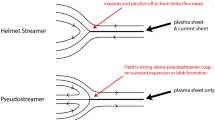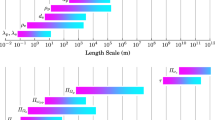Abstract
In the following paper we argue that each wind-driving star in relative motion with respect to the ambient interstellar medium experiences a force exerted on its central wind-generating body. The exact magnitude of this force depends on the actual geometry of the counterflow configuration of stellar and interstellar winds for a particular kinematic situation which is especially sensitive to whether the interstellar flow is subsonic or supersonic. It will, however, be demonstrated here that this force is of an accelerating nature, i.e., it operates like a rocket-motor, as long as the peculiar motion of the wind-driving star with respect to the ambient interstellar medium remains subsonic.
Here we use a specific analytical model to describe theoretically the specific counterflow configuration for the case of the solar system in a subsonic peculiar motion with respect to the local interstellar medium assuming irrotational and incompressible flows. We can work out a quantitative number for the accelerating force governing the Sun's motion at present. The net reaction force exerted on the solar body is then mediated by the asymmetric boundary conditions to which the distant solar wind field has to adapt.
Next we study the indirect action of such a force on orbiting Keplerian objects like planets, planetesimals and comets. Since this force only influences the central solar body, but not the planets themselves, the problem is different from the treatment of a constant perturbation force perturbing the Keplerian orbits. We present a perturbation analysis treating the action of a corresponding position-dependent perturbation force resulting in secular changes of the orbital elements of Keplerian objects. It is found that changes are accumulating more rapidly in time the closer to the sun the orbiting bodies are. Main axis and perihelion distances are systematically increasing. Especially pronounced are changes in the perihelion position angle of the objects. For solar wind mass losses larger than the Sun's present value by a factor of 1000 (T-Tauri phase of the Sun,) the migration periods calculated for the planet Mercury are of the same order of magnitude as that for corresponding general relativistic migration.
Similar content being viewed by others
References
Axford, W. I.: (1972), in “SOLAR WIND II’, NASA-Special Report SP-308, 609-653.
Baranov, V. B.: (1990),Space Sci. Rev. 52, 89–120.
Baranov, V. B., Lebedev, M. G., and Ruderman, M. S.: (1979),Astrophys. Space Sci. 66, 441–451.
Baranov, V. B.: (1990), In COSPAR-symposium onPhysics of the Outer Heliosphere, Pergamon Press, 287–299.
Bertaux, J. L.: (1984),Helium and Hydrogen of the LISM Observed in the Vicinity of the Sun, Proc. IAU Coll.81, 3–23
Brouwer, D., and Clemens, G. M., (1961),Methods of Celestial Mechanics, Academic Press, New York.
Burns, J. A., Lamy,P. L., and Soter, S.: (1979),Icarus 40, 1–48.
Cox, D. P. and Reynolds, R. J.: (1987),Ann. Rev. Astron. Astrophys. 25, 303–344.
Fahr, H. J.: (1986),Advances Space Res. 6(2, 13–25.
Fahr, H. J.: (1990), In: Proc. of COSPAR Symposium onPhysics of the Outer Heliosphere, Pergamon Press, Oxford, 327–346.
Fahr, H. J. and Neutsch, W.: (1983),Astron. Astrophys. 118, 57–65.
Fahr, H. J., Grzedzielski, S., and Ratkiewicz, R.: (1988),Annales Geophys. 6, 337–354.
Fahr, H. J., Fichtner, H. and Neutsch, W., (1990),Planet. Space Sci. 38, 383–394.
Fahr, H.J., Fichtner,H., and Neutsch,W. (1989),Astrophys. Space Sci. 153, 327.
Fahr, H. J. and Fichtner, H.: (1991),Space Science Reviews 58, 193–258.
Fahr, H. J., Fichtner, H., Scherer, K.: (1992),Astron. Astroph. (submitted).
Frisch, P. C., York, D. G., Fowler, J. R. (1987),Astrophys. J. 320, 842–849.
Frisch, P. C., Welty, D. E., York, D. G., and Fowler, J. R.: (1989),Astrophys. J. (submitted).
Fujimoto, Y., and Matsuda, T.: (1991),Mon. Not. Roy. Astr. Soc. (submitted).
Hadjidemetriou, J. D.: (1966),Icarus 5, 34–46.
Holzer,T.E. and Axford, W.I.: (197O),Ann. Rev. Astron. Astrophys. 8, 31–59.
Holzer,T.E.: (1977),J. Geophys. Res. 82, 23.
Holzer,T.E.: (1989),Ann. Rev. Astron. Astrophys. 27, 199–221.
Landau, L. D., Lifschitz, E. M.: (1978),Hydrodynamik, Akademie-Verlag, Berlin.
Matsuda, T., Fujimoto, Y., Shima, E., Sawada, K., and Inaguchi, T.: (1989),Progress of Theoret. Physics 81, 810–822.
Neutsch, W. and Fahr, H. J.: (1983),Mon. Not. Roy. Astr. Soc. 202, 735–752.
Neutsch, W. and Scherer, K.: (1992),Celestial Mechanics, Bibliographisches Institut, Mannheim.
Parker, E. N., (1963), In:Interplanetary Dynamical Processes, Interscience Publishers, New York.
Reynolds, R. J.: (1989),Astrophys. J. Lett. 339, L29-L32.
Ripken, H. W. and Fahr, H. J.: (1983),Astron. Astrophys. 122, 181–192.
Suess, S. T. and Nerney, S.: (1990),J. Geophys. Res. 95, 6403–6412.
Unsöld, A. and Baschek, B.: (1988),Der Neue Kosmos, Springer Verlag: Heidelberg, pp. 246–266.
Author information
Authors and Affiliations
Rights and permissions
About this article
Cite this article
Fahr, H.J., Scherer, K. The adapted solar wind system as cause for a momentum transfer to the sun and its consequences for the orbital motions of keplerian objects. Astrophys Space Sci 201, 321–340 (1993). https://doi.org/10.1007/BF00627204
Received:
Issue Date:
DOI: https://doi.org/10.1007/BF00627204




